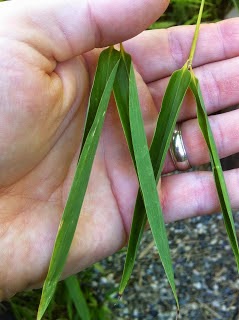Yes, somewhat - but it really depends.
OK, so not the clearest answer, but let me explain.
Clumping bamboo tends to be more drought tolerant that its running cousin because it grows slightly deeper, on average. This lends the ability to have more water supply opportunities for the plant, much like a tree with a deep taproot would. However, generally this would require the bamboo to have a mature, established root mass. So, if your planting a brand new bamboo plant, don't expect to treat it like a California Poppy (which is a very drought tolerant California native plant). A new bamboo plant, like most plants, require regular water in the first full going season for the roots to grow and become established.
Bambusa ventricosa 'Buddha's Belly Bamboo' and Bambusa multiplex 'Alphonse Karr' (both far left of photo) doing well in our water efficient front yard. By removing the front yard grass and watering efficiently in both the front and back yard, we realized a 58 percent reduction from the same time last year.
After that, you could be moderately miserly, to some extent with water, but the trade-off is that the growth of the bamboo plant will slow and it won't be as lush as it would with a consistently moist soil. But there are limits, and your bamboo plant will show it with yellowing leaves and curling leaves.
So, one other myth to dispel (bamboo carries a lot of myths with it) - bamboo likes soggy, wet soils. In fact, many visualize bamboo you see in the jungle - jungles get a lot of rain and thus all bamboo must like soggy soil. Well, not really. Some bamboo can tolerate soggy soils, but the vast majority do not. If fact, soggy soils over an extended period of time lead to root rot, which will ultimately kill the bamboo plant outright. Don't get me wrong, bamboo likes regular watering, like an average medium water use plant, and can tolerate some dryness, but moderation is the key.
So - with this drought - here are some easy strategies to keep your bamboo happy and while using water wisely.
- First, mulching is a great way to extend moisture around the plant and slow evaporation of water. Plus a good mulch offers other fertilizing benefits to the bamboo as well.
- Supplement your water that would have normally gone down the drain. Many Californians are using a low tech solution to capture and use water that would have normally just gone down the drain. While warming your bath or sink water, put a bucket to capture that water. Use the water (at room temperature) to water your bamboo.
- Water your bamboo plant in the early morning to minimize evaporation and allow the plant to maximize the intake of the water provided, before air temperatures rise.
- Pay attention to your bamboo plant - if you get leaf curling, its a signal that your bamboo needs to be watered. Short periods of dryness are OK - but don't push it.
For many, droughts offers unique opportunities to learn and adapt to extraordinarily dry conditions. Bamboo can survive in a drought, it just takes a deeper understanding of the plant and its needs, coupled with common-sense water efficiency practices that apply really to any type of landscape circumstance.
Sean
Mad Man Bamboo Nursery - Rocklin
www.madmanbamboo.com
Facebook - www.facebook.com/madmanbamboo
Twitter - @madmanbamboo




No comments:
Post a Comment